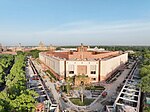Central Secretariat metro station

The Central Secretariat (often abbreviated Central Sectt on platforms and trains) is a Delhi Metro station in Delhi, on the Yellow Line. The Violet Line links it with Badarpur Border. The station provides a same-level interchange between the two lines. It was the southern terminus of the Yellow line from 2005 to September 2010, and the northern terminus of the Violet Line from 3 October 2010 to 26 June 2014.Nearby landmarks include Krishi Bhavan, and the Parliament House and Secretariat Building. Many DTC buses terminate outside the nearby Kendriya Terminal, including the 7 (Kewal Park), 185 (Nathul Pura), 190 (Burari), 260 (Harsh Vihar), 270 (Karawal Nagar), 271 (Jagat Pur Temple) and 581 (Deoli).
Excerpt from the Wikipedia article Central Secretariat metro station (License: CC BY-SA 3.0, Authors, Images).Central Secretariat metro station
Rafi Ahmed Kidwai Marg, New Delhi Rakab Ganj (Chanakya Puri Tehsil)
Geographical coordinates (GPS) Address Nearby Places Show on map
Geographical coordinates (GPS)
| Latitude | Longitude |
|---|---|
| N 28.615042 ° | E 77.211785 ° |
Address
Central Secretariat Metro Gate No 4
Rafi Ahmed Kidwai Marg
110004 New Delhi, Rakab Ganj (Chanakya Puri Tehsil)
Delhi, India
Open on Google Maps









